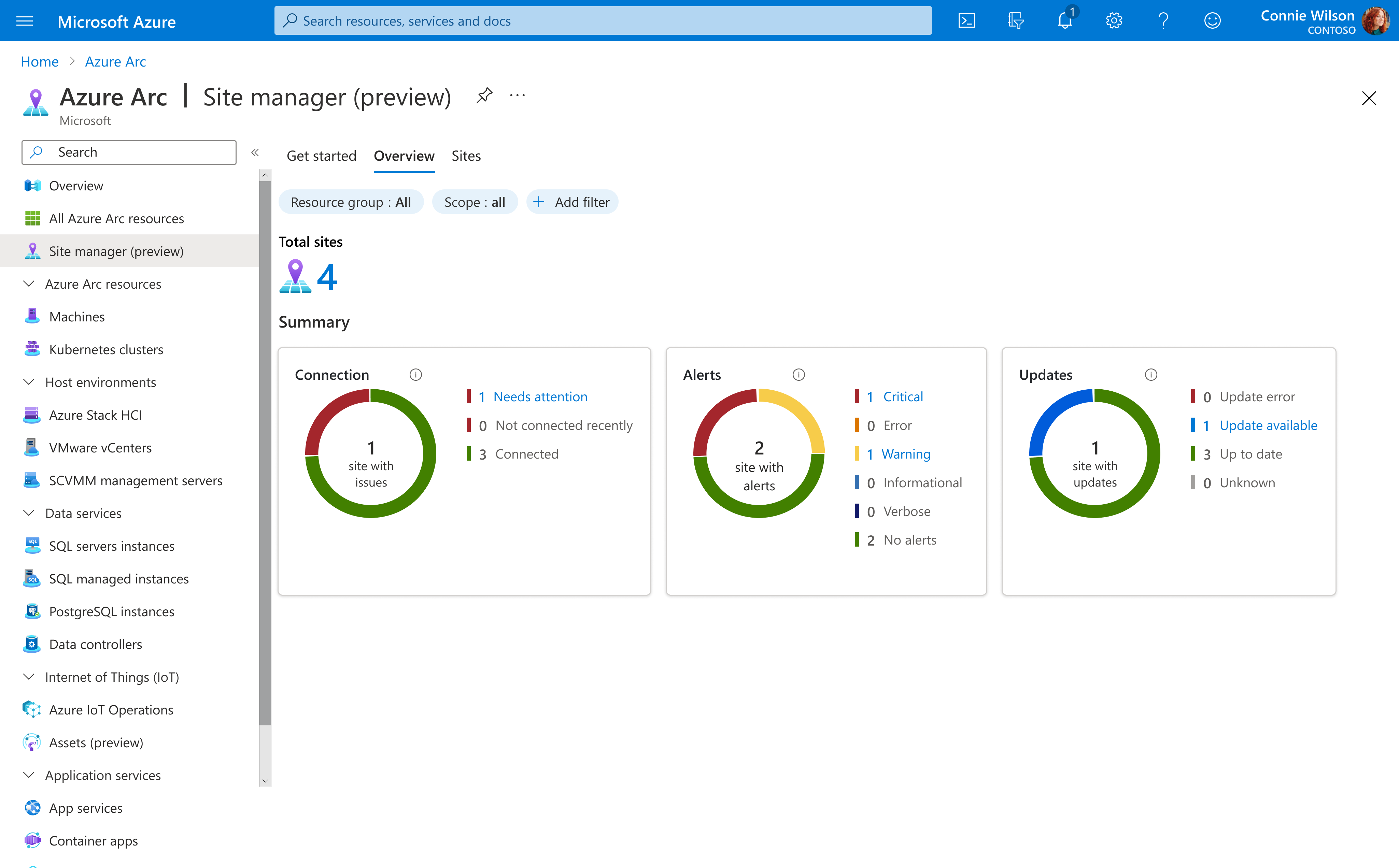Public Preview of Azure Arc Site Manager

This week we are excited to announce the Public Preview of Azure Arc site manager. We designed site manager to meet the needs of customers who manage solutions on the adaptive cloud and want to view and monitor their resources according to their physical locations, such as stores, restaurants, and factories. Within site manager, customers can create Arc sites to represent their on-premises environments and see centralized monitoring information across their edge infrastructure.
Get Started
You can get started by navigating to site manager within Azure Arc (aka.ms/sitemanager). Sites can be created on a resource group or subscription today, and site manager currently supports Azure Stack HCI, Azure Arc-enabled servers & VMs, Azure Arc-enabled Kubernetes, and Azure IoT Operations assets. After site creation, all supported resources automatically appear within the site.
For at-scale scenarios, Arc sites can also be created via Infrastructure-as-Code. To learn more, see aka.ms/IaCQuickstart.
Site Monitoring Capabilities
Once the site is created, you can see aggregated connectivity, alerts, and updates for the site. Connectivity status comes automatically for supported resources, update status via Azure Update Manager, and alerts through Azure Monitor, which can be configured following this guidance. Additionally, each Arc site has its own page where more detailed troubleshooting and remediation can be performed.
Coming Soon
Site manager is currently in public preview, and the following features will come soon:
- Ability to create sites on a subset of resources in multiple resource groups and/or subscriptions
- Support for more resource types, including Arc-enabled SQL servers, Arc-enabled VMware vSphere, and some cloud resources
- Expansion to security and health monitoring
Next Steps
Check out our documentation (aka.ms/sitedocs) and go to the Azure portal to try out Azure Arc site manager today (aka.ms/sitemanager). Additionally, feel free to provide feedback to our team here.
Published on:
Learn moreRelated posts
Automating Business PDFs Using Azure Document Intelligence and Power Automate
In today’s data-driven enterprises, critical business information often arrives in the form of PDFs—bank statements, invoices, policy document...
Azure Developer CLI (azd) Dec 2025 – Extensions Enhancements, Foundry Rebranding, and Azure Pipelines Improvements
This post announces the December release of the Azure Developer CLI (`azd`). The post Azure Developer CLI (azd) Dec 2025 – Extensions En...
Unlock the power of distributed graph databases with JanusGraph and Azure Apache Cassandra
Connecting the Dots: How Graph Databases Drive Innovation In today’s data-rich world, organizations face challenges that go beyond simple tabl...
Azure Boards integration with GitHub Copilot
A few months ago we introduced the Azure Boards integration with GitHub Copilot in private preview. The goal was simple: allow teams to take a...
Microsoft Dataverse – Monitor batch workloads with Azure Monitor Application Insights
We are announcing the ability to monitor batch workload telemetry in Azure Monitor Application Insights for finance and operations apps in Mic...
Copilot Studio: Connect An Azure SQL Database As Knowledge
Copilot Studio can connect to an Azure SQL database and use its structured data as ... The post Copilot Studio: Connect An Azure SQL Database ...
Retirement of Global Personal Access Tokens in Azure DevOps
In the new year, we’ll be retiring the Global Personal Access Token (PAT) type in Azure DevOps. Global PATs allow users to authenticate across...
Azure Cosmos DB vNext Emulator: Query and Observability Enhancements
The Azure Cosmos DB Linux-based vNext emulator (preview) is a local version of the Azure Cosmos DB service that runs as a Docker container on ...


